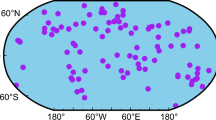Abstract
Network-based real-time kinematic (NRTK) GNSS (Global Navigation Satellite System) positioning system is one of the most commonly used in many countries for various applications which require instant and highly accurate positioning all around the clock. The main principle of this system is to generate reliable error models that can mitigate dispersive (e.g., ionospheric delay) and non-dispersive (e.g., tropospheric delay and orbit biases) errors which are the main sources for the degradation of the positioning accuracy. There are several correction techniques that have been implemented and used in NRTK concept. The objective of this study is to evaluate accuracy, precision, time to first fix (TTFF), and performance of carrier phase ambiguity fixing while maintaining the same survey conditions for VRS, FKP, and MAC NRTK techniques. The Turkish TUSAGA-Aktif CORS network was used to obtain the three NRTK corrections. In terms of accuracy, our results show that all the techniques are practically the same and the horizontal positioning accuracy is in the order of few centimeters for all techniques. As far as precision and TTFF are concerned, VRS produced slightly better results comparing to the others. When it comes to ambiguity fixing performance in the dynamic environment, FKP produced the best results.










Similar content being viewed by others
References
Alçay S, İnal C, Yiğit CO, Yetkin M (2012) Comparing GLONASS-only with GPS-only and hybrid positioning in various length of baselines. Acta Geod Geop Hung 47(1):1–12
Berber M, Arslan N (2013) Network RTK: a case study in Florida. Measurement 46:2798–2806
Brown N, Keenan R, Richter B, Troyer L (2005) Advances in ambiguity resolution for RTK applications using the new RTCM V3. 0 Master-Auxiliary messages. Proc of ION GNSS, Long Beach, California 73–80
Brown N, Geisler I, Troyer L (2006) RTK rover performance using the Master-Auxiliary Concept. J Glob Positioning Syst 1-2:135–144
Dai L, Wang J, Rizos C, Han S (2003) Predicting atmospheric biases for real-time ambiguity resolution in GPS/GLONASS reference station networks. J Geod 76:617–628
Dodson AH, Shardlow PJ, Hubbard LCM, Elgered G, Jarlemark POJ (1996) Wet tropospheric effects on precise relative GPS height determination. J Geod 70:188–202
Dow JM, Neilan RE, Gendt G (2005) The International GPS Service: celebrating the 10th anniversary and looking to the next decade. Adv Space Res 36:320–326
Gumus K, Celik CT, Erkaya H (2012) Investigation of accurate method in 3-D position using CORS-NET in Istanbul. Bol Ciênc Geod 2:171–184
Hu GR, Khoo VHS, Goh PC, Law CL (2002) Internet based GPS VRS RTK positioning with multiple reference station network. J Glob Positioning Syst 2:113–120
Janssen V, Haasdyk J (2011) Assessment of network RTK performance using CORSnet-NSW. International Global Navigation Satellite Systems Society IGNSS Symposium, Sydney, Australia
Landau H, Vollath U, Chen X (2002) Virtual reference station systems. J Glob Positioning Syst 2:137–143
Mekik C, Yıldırım O, Bakıcı S (2011) An overview of RTK network of the Turkish Republic (TUSAGA-Aktif). International Global Navigation Satellite Systems Society IGNSS Symposium, Sydney, Australia
Neill AE (1996) Global mapping functions for the atmospheric delay at radio wavelengths. J Geophys Res 111:3227–3246
Neill AE (2000) Improved atmospheric mapping functions for VLBI and GPS. Earth Planets Space 52:699–702
Olynik M, Petovello MG, Cannon ME, Lachapelle G (2002) Temporal variability of GPS error sources and their effect on relative positioning accuracy. Institute of Navigation National Technical Meeting, San Diego, California
Vollath U, Buecherl A, Landau H, Pagels C, Wagner B (2000) Multi-base RTK positioning using virtual reference stations. Proc of 13th International Technical Meeting of the Satellite of the ION, Salt Lake City, UT 123-131
Wang C, Feng Y, Higgins M, Cowie B (2010) Assessment of commercial network RTK user positioning performance over long inter-station distances. Journal of Global Positioning Systems 1:78–89
Wanninger L (1999) The performance of virtual reference stations in active geodetic GPS-networks under solar maximum conditions. Proc. of ION GPS, Nashville, TN 1419-1427
Wanninger L (2004) Ionospheric disturbance indices for RTK and network RTK positioning. Proc. Ion GNSS, Long Beach, California 2849–2854
Wübenna G, Bagge A, Schmitz M (2001) Network–based techniques for RTK applications. GPS Society, Japan Institute of Navigation, Tokyo, Japan
Wübenna G, Schmitz M, Bagge A (2005) PPP-RTK: precise point positioning using state-space representation in RTK networks. 18th International Technical Meeting of the Satellite Division of The Institute of Navigation, Long Beach, California 2584–2594
Author information
Authors and Affiliations
Corresponding author
Rights and permissions
About this article
Cite this article
Öğütcü, S., Kalayci, I. Investigation of network-based RTK techniques: a case study in urban area. Arab J Geosci 9, 199 (2016). https://doi.org/10.1007/s12517-015-2262-0
Received:
Accepted:
Published:
DOI: https://doi.org/10.1007/s12517-015-2262-0




